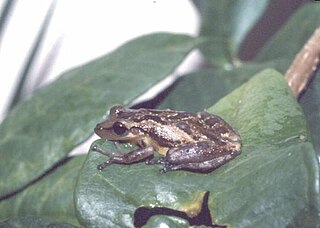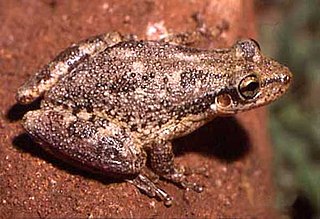
The African common toad or guttural toad is a species of toad in the family Bufonidae. It is found in Angola, Botswana, Democratic Republic of the Congo, Kenya, Lesotho, Malawi, Mauritius, Mozambique, Namibia, Réunion, Somalia, South Africa, Ethiopia, Eswatini, Tanzania, Zambia, and Zimbabwe. Its natural habitats are subtropical or tropical dry forest, subtropical or tropical moist lowland forest, subtropical or tropical moist montane forest, dry savanna, moist savanna, temperate shrubland, subtropical or tropical dry shrubland, subtropical or tropical moist shrubland, subtropical or tropical dry lowland grassland, subtropical or tropical seasonally wet or flooded lowland grassland, subtropical or tropical high-altitude grassland, intermittent rivers, freshwater lakes, intermittent freshwater lakes, freshwater marshes, intermittent freshwater marshes, arable land, pastureland, rural gardens, urban areas, heavily degraded former forest, ponds, and canals and ditches.

The Manaus slender-legged tree frog, also known as the giant broad-headed tree frog, is a species of frog in the family Hylidae found in Bolivia, Brazil, Colombia, Ecuador, French Guiana, Guyana, Peru, Suriname, and Venezuela. Its natural habitats are subtropical or tropical dry forest, subtropical or tropical moist lowland forest, moist savanna, rivers, intermittent freshwater marshes, and canals and ditches. It is threatened by habitat loss. It is also reported to produce Bufotenin.

Brimley's chorus frog is a species of frog in the family Hylidae. It is endemic to the United States and is named for North Carolina zoologist C.S. Brimley.

Scinax acuminatus is a species of frog in the family Hylidae. It is found in Argentina, Bolivia, Brazil, Paraguay, and possibly Uruguay. Its natural habitats are moist savanna, subtropical or tropical moist shrubland, subtropical or tropical seasonally wet or flooded lowland grassland, freshwater lakes, intermittent freshwater lakes, freshwater marshes, intermittent freshwater marshes, pastureland, rural gardens, heavily degraded former forest, ponds, and canals and ditches. It breeds in bodies of water. It is threatened by eventual habitat loss, but the population is currently fairly stable, as it adapts fairly well to human encroachment and development.

Scinax boulengeri is a species of frog in the family Hylidae. It is found in Colombia, Costa Rica, Nicaragua, Panama, and possibly Honduras. Its natural habitats are subtropical or tropical moist lowland forests, intermittent freshwater marshes, pastureland, plantations, rural gardens, and urban areas. It has been found as high as 600 meters above sea level.
Scinax caldarum is a species of frog in the family Hylidae. It is endemic to Brazil. Its natural habitats are subtropical or tropical seasonally wet or flooded lowland grassland, subtropical or tropical high-altitude grassland, freshwater marshes, intermittent freshwater marshes, pastureland, rural gardens, ponds, and canals and ditches. It is threatened by habitat loss.

Scinax crospedospilus is a species of frog in the family Hylidae. It is endemic to Brazil. Its natural habitats are subtropical or tropical moist shrubland, subtropical or tropical seasonally wet or flooded lowland grassland, subtropical or tropical high-altitude grassland, freshwater marshes, intermittent freshwater marshes, pastureland, heavily degraded former forest, ponds, and canals and ditches.

Scinax cuspidatus is a species of frog in the family Hylidae. It is endemic to Brazil. Its natural habitats are subtropical or tropical moist lowland forests, subtropical or tropical moist shrubland, subtropical or tropical dry lowland grassland, freshwater marshes, intermittent freshwater marshes, rocky areas, heavily degraded former forest, and ponds. It is threatened by habitat loss.

Scinax eurydice is a species of frog in the family Hylidae. It is endemic to Brazil. Its natural habitats are subtropical or tropical moist lowland forests, subtropical or tropical moist shrubland, subtropical or tropical seasonally wet or flooded lowland grassland, swamps, freshwater lakes, intermittent freshwater lakes, freshwater marshes, intermittent freshwater marshes, heavily degraded former forest, and ponds. It is threatened by habitat loss.

Scinax garbei is a species of frog in the family Hylidae. It is found in Bolivia, Brazil, Colombia, Ecuador, Peru, Venezuela, and possibly Guyana. Its natural habitats are subtropical or tropical moist lowland forests, subtropical or tropical swamps, rivers, intermittent freshwater marshes, plantations, rural gardens, heavily degraded former forest, and ponds.

Scinax granulatus is a species of frog in the family Hylidae. It is found in Argentina, Brazil, Paraguay, and Uruguay. Its natural habitats are temperate shrubland, subtropical or tropical moist shrubland, temperate grassland, subtropical or tropical seasonally wet or flooded lowland grassland, freshwater lakes, freshwater marshes, intermittent freshwater marshes, pastureland, plantations, rural gardens, urban areas, water storage areas, ponds, and canals and ditches.

Scinax hayii is a species of frog in the family Hylidae. It is endemic to Brazil. Its natural habitats are subtropical or tropical moist lowland forests, subtropical or tropical moist montane forests, rivers, freshwater marshes, intermittent freshwater marshes, pastureland, urban areas, heavily degraded former forest, and ponds.

Scinax nasicus is a species of frog in the family Hylidae. It is found in Argentina, Bolivia, Brazil, Paraguay, and Uruguay. Its natural habitats are subtropical or tropical dry forests, moist savanna, temperate shrubland, subtropical or tropical dry shrubland, subtropical or tropical moist shrubland, subtropical or tropical high-altitude shrubland, temperate grassland, subtropical or tropical seasonally wet or flooded lowland grassland, freshwater lakes, intermittent freshwater lakes, freshwater marshes, arable land, pastureland, plantations, rural gardens, heavily degraded former forest, water storage areas, ponds, and canals and ditches.

The blue-headed snouted tree frog or Spix's snouted tree frog is a species of frog in the family Hylidae. It is found in Bolivia, Brazil, French Guiana, Guyana, Suriname, and Venezuela. Its natural habitats are subtropical or tropical moist lowland forests, moist savanna, intermittent freshwater marshes, pastureland, rural gardens, and heavily degraded former forest. It is threatened by habitat loss.
Scinax pachycrus is a species of frog in the family Hylidae. It is endemic to Brazil. Its natural habitats are dry savanna, subtropical or tropical dry shrubland, subtropical or tropical dry lowland grassland, intermittent freshwater marshes, rocky areas, arable land, pastureland, and ponds. It is threatened by habitat loss.

Scinax perereca is a species of frog in the family Hylidae. It is found in Brazil, Argentina, and Paraguay. Its natural habitats are subtropical or tropical moist lowland forests, freshwater marshes, intermittent freshwater marshes, heavily degraded former forest, ponds, and canals and ditches. It is threatened by habitat loss.

Scinax staufferi is a species of frog in the family Hylidae. It is found in Belize, Costa Rica, El Salvador, Guatemala, Honduras, Mexico, and Nicaragua. Its natural habitats are subtropical or tropical dry forests, subtropical or tropical moist montane forests, moist savanna, subtropical or tropical seasonally wet or flooded lowland grassland, freshwater marshes, intermittent freshwater marshes, pastureland, rural gardens, heavily degraded former forest, ponds, and canals and ditches.
Scinax sugillatus, also known as the acute tree frog, is a species of true frog in the tree frog family, Hylidae. It is found in Colombia and Ecuador.

Julianus uruguayus is a species of frog in the family Hylidae. It is found in Argentina, Brazil, and Uruguay. Its natural habitats are moist savanna, subtropical or tropical seasonally wet or flooded lowland grassland, freshwater marshes, and intermittent freshwater marshes. It is threatened by habitat loss.

Scinax tymbamirim is a frog in the family Hylidae. It is endemic to Brazil.


















